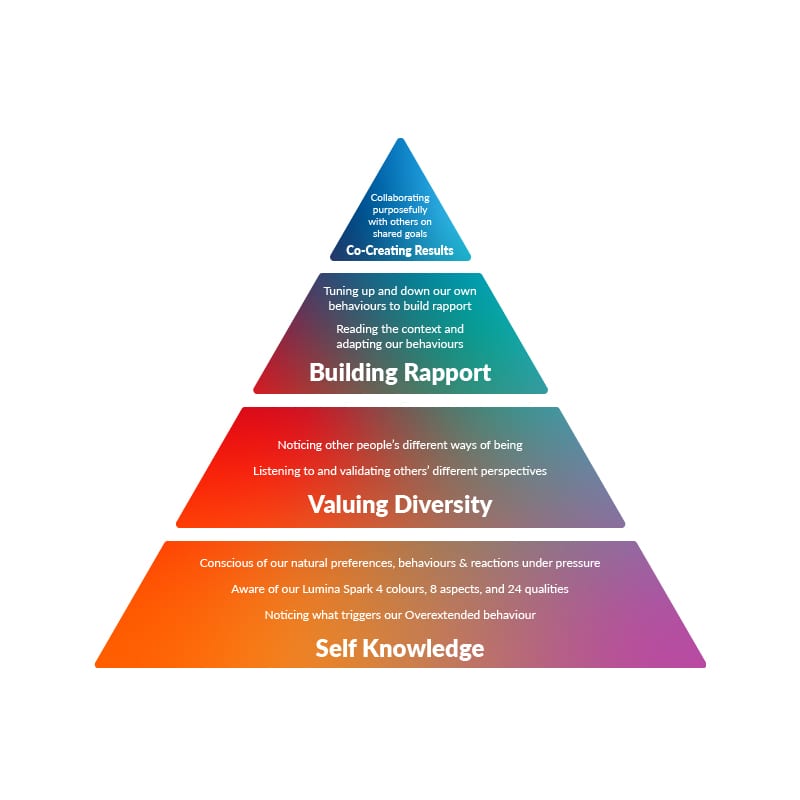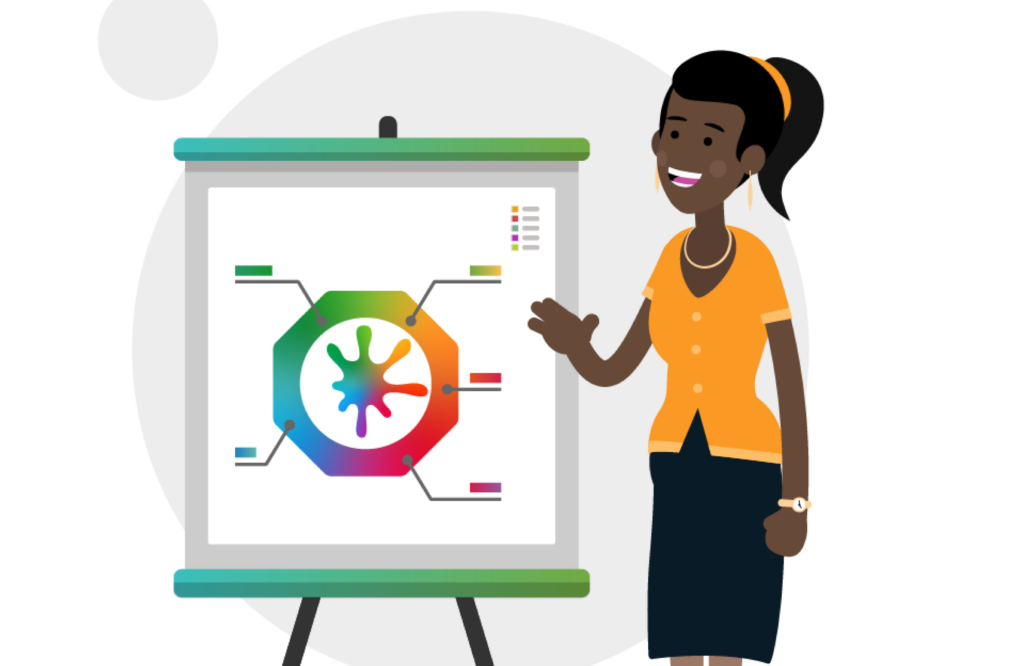Self-awareness as key to team coaching
As coaches we understand that a key skill is self-awareness and the ability to manage ourselves in the coach-client dynamic, sometimes to get into the way to provoke a change of direction and other times to get out of the way as our clients reflect and select their course of action. This is even more important in team coaching to help the team and its members understand who they are as individuals, and how their approach can on occasion enhance and on other occasions inhibit team performance. In this guide we explore the Lumina Spark lens as one way to deepen team awareness and thus aid team performance.
The Challenges of team coaching
Being a team coach has never been more challenging than it is today. The vast availability of research and advice on how to coach has mushroomed over the last decade, while at the same time the complexity of working with a team is a challenge.
The 4 Lumina Spark Principles, when applied using the 24 Quality Lumina Spark personality model, can help coaches to explore the gap that exists between team members’ well-intended behaviours and the actual impact they have across the team.
Lumina Spark 4 Principles

Figure 1: Lumina Spark4 Principles as an ‘up hierarchy’
All good coaches know that at their core they are expert communicators. Interestingly, it turns out that to communicate well, we actually have to start by turning our attention inward in order to claim our sense of purpose and increase our self- knowledge.
These principles form an ‘up hierarchy’, whereby the principles at the lower level of the pyramid are mastered before moving up to the next level.
At the base of the pyramid, the first principle is ‘Self Knowledge’. This is the foundation stone that underpins effective 21st-century coaching. Raising self-awareness is the first step for working effectively with others and a key trait for the most successful coaches. The understanding of self and others is deepened by appreciating the range of personalities, strengths, work styles, and communication preferences.
The second principle is that of ‘Valuing Diversity’ and enables respect for each client and their work and life purposes. Generating an inclusive coaching environment increases engagement in the coaching process and supports self-development. Every client can become more authentic, open, and confident in the knowledge that they are valued as unique human beings, supported by their coach.
The third principle is termed ‘Building Rapport’ and enhances the connection between the coach and client. Understanding and adapting to clients’ communication styles is the key to building a closer and more trusting relationship with the client. This essential component of coaching ensures that time is no longer wasted on miscommunications or negative assumptions. The coach and client’s energy can be focused on developing a fruitful coaching process.
At the top of the pyramid is the principle of ‘Co-Creating Results’ – the final step in supporting the client to achieve the true purpose. There is extensive evidence that real collaboration and support provides better results for the client. This includes the coach knowing when collaboration means intervening in the team to change direction, as well as when to support the team by getting out the way to make space for the team to reflect and plan action themselves.
Team Coach as role model
Each of these 4 principles are best practised by the coach themselves as they role model them as part of their team coaching practice. When they do this, the coach fulfils dual roles through directly coaching the team towards higher performance, whilst simultaneously encouraging the team to embrace the 4 principles role modelled. This engages Rogers (1983) humanistic approach to social learning at the heart of the team coaching.
Furthermore, each of these 4 principles can be best applied through a coach’s understanding of their own and their team’s 24 Qualities displayed on the Lumina Spark mandala. A coach and a client’s style can be effectively displayed as a painted Splash on the mandala, as shown in Figure 2.

Figure 2: Lumina Spark 24 Quality Mandala (Desson, Ensor & Cannon, 2018).
Developing self-awareness
Fundamental to the coach’s working with all 4 of the principles, is the need for self-awareness using the Lumina Spark mandala. With 24 Qualities around the outer rim, the Lumina Spark mandala allows us to understand which of our instinctive Underlying Qualities are fundamental to our being. It also enables us to see which Qualities are most appropriate for us to express based on who we are with and the given context, and how these may impact on our team interactions.
How can we apply this in a team coaching context?
Team Coaches seek to provide their teams with a genuine ‘Aha!’ moment. To support this, they can use the easy-to-grasp language and impactful visuals of the Lumina Spark mandala to highlight the qualities and behaviours within a team. This can help the team investigate its own character as well as understand how other people view them.
The key to creating a high performing team lies in really understanding each other’s personality, motivation and preferred communication style. Understanding deeper values and preferences fosters the respect necessary for people to work effectively together. With this awareness, team members can then co-create a high-performing team environment.
The benefit a team coach can bring through this process includes:
- Through a deeper understanding of the team’s shared strengths and possible blind spots, everybody will commit to their personal and collective growth
- Coach and team members can visually explore their team’s dynamics through an animated online App – see Figure 3.
- Through the coach role modelling inspiring yet practical language to describe team behaviours, the team learns to value the diversity within it
- The team benefits from deeper connections, stronger communication skills and a sense of shared purpose

Figure 3: Lumina Team Mandala – each dot is an individual, and the large dot is the team’s most commonly used communication style
How does this help team coaches close the gap between their good intentions and their actual impact?
Firstly, the Lumina Spark approach helps coaches take a humanistic approach – viewing people as ‘human beings’ rather than ‘human doings’, and so helps them transform their client’s performance.
Secondly, the model helps coaches view themselves and others without bias. No labelling, boxing, or stereotyping. Coaches have a tool to understand their whole way of being and their client’s way of being, to explore potential without limits.
Thirdly, this approach fundamentally avoids false dichotomies. With Lumina Spark, individuals are not simply extraverted or introverted, not just a thinker or a feeler. Unlike other approaches, Lumina Spark shows coaches how to work with all aspects of their client’s personality. In a nutshell, coaches can now help others embrace the paradox of who they really are and better support their performance improvement.
Finally, this approach measures three parts of who a client is (we call them ‘personas’) – the Underlying, Everyday, and Overextended you. This helps individuals understand the full dynamic of their personality. The three personas are presented in an easily grasped graphical format that helps people quickly make sense of themselves and take meaningful action to enhance their own and the team’s performance.
For more articles on team development and self-awareness, subscribe here.
References
Desson, S. G., Benton, S. & Golding, J. (2014). Measuring Both Ends of the Big Five Personality Scales Independently. Presented at International Conference on Psychotechnology (ICOP) September 2014, Faculty of Humanities, Bina Nusantara University, Jakarta, Indonesia. Accessed online https://luminalearning.com/resources/downloads-files
Desson, S. G. (2017). Development of an Integrated Adaptive and Maladaptive Personality Model for Measuring the Big Five. PhD thesis awarded by the University of Westminster. Accessed online https://westminsterresearch.westminster.ac.uk/item/q3xw6/development-of-an-integrated-adaptive-and-maladaptive-personality-model-for-measuring-the-big-five
Desson, S. G., Ensor, J. & Cannon, J. (2018). Validation of Lumina Spark and Emotion against the Great Eight Competencies. Presented at BPS DOP Conference 2018. Accessed online https://luminalearning.com/resources/downloads-files
Rogers, C. R., & Allender, J. A. (1983). Freedom to learn for the 80’s.
Henley boiler plate
Stewart Desson is an experienced Business Psychologist, the CEO and founder of Lumina Learning, and the author of the innovative Lumina Spark psychometric.
Read other Articles
See our global network



 The Big Challenge: helping organisations adapt to a new (virtual) world
The Big Challenge: helping organisations adapt to a new (virtual) world